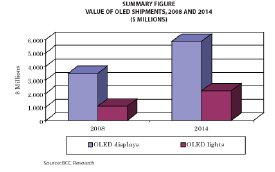Oct 14 2009
According to a new technical market research report, Organic Light Emitting Diodes (OLEDs): Technologies and Global Markets (SMC069A) from BCC Research, the global market for organic light-emitting diodes was worth $4.5 billion in 2008, decreased to $3.9 billion in 2009, and is expected to increase to nearly $8.1 billion in 2014. The compound annual growth rate (CAGR) for the 5-year period would be 15.3%.

LEDs, both organic and inorganic, have been part of the movement to provide more efficient illumination while reducing contaminants and, in the long run, costs. Known as "solid-state lighting," this technology holds a lot of promise for the future.
The organic light-emitting diode (OLED) has been challenging the other flat-panel technologies in the electronic display industry for several decades. The liquid-crystal display (LCD) has taken a commanding lead in that industry but is being challenged in certain form factors by the OLED. BCC Research examines the potential of the organic technology to compete with the LCD and other displays for handheld, monitor and television applications, and in the OLED as a solid-state lighting product.
In this study, BCC concludes that the organic light-emitting diode display has an excellent future, especially as improvements are made and costs decline. Once thought to be only for small devices, the OLED is now competing with televisions and early models received favorable ratings. OLEDs have proved to be excellent in small handheld products as well as in larger TV sets, and the OLED presents the closest technology to liquid-crystal display, which has become entrenched in the display world. It also has a couple of advantages over the LCD:
- It is an emissive device and needs no backlight
- It has a wide viewing angle of 170 degrees
- The OLED is the thinnest display device available at this time and is power-saving.
BCC also finds that OLED lighting technology has progressed over the past 10 years. OLED lights have been used for signage and specialty applications with increasing success. Lately, more LCD backlights have been composed of OLEDs and the field of architecture recognizes the soft lighting that improves the design of a specific area. BCC concludes that the largest field for growth in this part of solid-state lighting is general illumination and further anticipates the OLED lighting market falling into four measurable categories over the forecast period of this report:
- Signage lighting
- Display backlights
- Architectural and specialty lighting
- General illumination
According toOrganic Light Emitting Diodes (OLEDs): Technologies and Global Markets,OLED displays dominate the market, generating $3.5 billion in sales in 2008 but decreasing to $2.9 billion in 2009. Sales are expected to increase in the next 5 years to reach nearly $5.9 billion in 2014, for a CAGR of 14.9%. The OLED lights market amounted to more than $1 billion in 2008, and is projected to decrease slightly in 2009, but rebound to $2.2 billion in 2014, for a 5-year CAGR of 16.5%.